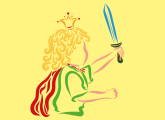Three group P4C activities that are certain to get children thinking…
P4C, or Philosophy for Children, is an educational approach that encourages young children to engage in philosophical enquiry.
It aims to develop their critical thinking, reasoning and dialogue skills through age-appropriate discussions and activities.
Whole-class P4C enquiries are weekly sessions that begin as 15- to 30-minute activities. They are designed to consolidate and reinforce the rules of enquiry and dialogue.
We start in a circle facing each other. Our rules are that only one person may talk at a time, but we do not use ‘hands up’. You’ll need adult support initially to help children talk together in this way.
We also agree to keep our bodies calm and still and look at the person talking. We call this ‘finding our space’.
The P4C activities that follow involve children deciding on and justifying choices. In the early days of P4C enquiry, I give each child a double-sided voting card. One side has a smiley face to indicate a positive choice, e.g. yes/agree/good thing. The other side has a neutral face to indicate an opposing choice, e.g. no/disagree/bad thing.
Use the cards to check whether thinking remains consistent or changes. Alternatively, you may wish to use children’s own name labels, which they can place on yes or no cards to indicate their choices.
Stimulus: Large drawing of a monster.
Stimulus details: Draw a monster with a closed mouth (no teeth), three arms, four legs and a tail. Ensure that it looks neither friendly nor frightening.
Skill focus: Sharing ideas. Listening as part of a group. Making a decision. Revisiting a question after dialogue.
Thinking focus: Should we judge from appearance only?
Presentation
Explain to the children that you have a difficult decision to make. You met a monster on the way home last night and he asked if he could come to nursery tomorrow.
Making a decision
Ask the children to vote on their answer to this question using double-sided voting cards. Alternatively, use a ‘stand up/sit down’ vote.
Conversation and thinking time
Ask those children to form two groups based on how they voted. Allow the children a few minutes to share their reasons within the groups.
First words
Ask the children with the majority vote to share their reasons. Encourage the children from both groups to give their reasons. What would be the good things and the bad things about having a monster at nursery?
Building
Introduce further facts about the monster to see if it changes thinking. For example, what if this monster smelt really bad? What if the monster was so small he could fit into a pocket?
Last words
Review the main ideas put forward, then revisit the original question. Have any children changed their answers? If so, ask them if they can say why.
Stimulus: Playdough people and the following letter from Planet Leader.
Stimulus details: Letter from the Planet Leader.
Dear People,
I am giving you a very important job. I am going on holiday and need you to carry on my work. You must create some people for my new planet. They must be the very best people in every way.
Please let me know all about the people you make. I have given you some people-making material. Please create carefully. We cannot risk any mistakes.
Thank you.
Leader of Planet Plato.
Skill focus: First thoughts. Clarifying ideas.
Thinking focus: What is a person?
Preparation
Allow time for children to explore books and stories about a variety of people.
Presentation
This activity is best done in smaller groups of five or six children at a time, working around a table. Prepare enough playdough for each child to form a model person (you may wish to provide different colours).
Read the stimulus letter to them and ask them if they can make the perfect person. Join in this activity yourself.
Conversation and thinking time
While the children create their ‘people’, they can chat informally about what they are doing to make their person. What does it need to look like? What colour have they chosen?
First words
As the models progress, ask the children questions such as “Would it matter if your person had no arms? Eyes? Heart? Legs?”, etc.
Allow them to express their ideas about what makes a perfectly functioning person.
Building
Introduce the idea that the person you have made might not be accepted by the leader because it is sometimes badly behaved.
Can they suggest some things that it does wrong? Ask the children if they can help you ‘fix’ your person so that it is perfect again.
Last words
Do the children think there can ever be the perfect person, or is it all right if they make mistakes or look different?
Stimulus: Fairy tale characters/cards and large paper/pens.
Stimulus details: Prepare an invitation from the ‘King’ requesting help from the children to decide which characters should be invited to the royal party and why.
Skill focus: Making a decision and justifying it. Persuasive argument. Working as a community to reach agreement. Listening to others. Sensitivity to disagreement.
Thinking focus: Identifying behaviours of fairy tale characters. Thinking about what constitutes good behaviour. Caring thinking.
Preparation
Ensure children are familiar with fairy tales. Allow opportunities for role-play as fairy tale characters.
Presentation
Read the invitation asking the children to help. Enlist the children to take out the figures/cards from a bag one at a time and talk together about who/what the characters are.
Allocate each child with a figure/card of his or her choice. Explain that the children will be speaking on behalf of their characters to give a reason why they should be allowed to attend the royal party.
Conversation and thinking time
Ask children to look carefully at the collection of figures/cards and discuss in small groups their first thoughts on the behaviours of each other’s characters.
First words
Ask volunteers to ask explain why their character should be allowed to attend the party.
Building
Encourage the children to help each other find reasons why characters should be allowed to attend, and to wonder if there are reasons why characters might have behaved badly.
For example, is the wolf really bad if he only ate the pig because he was starving? Do dragons know they are scary and can they help it? Was the giant right to have been cross if Jack had stolen his gold?
Last words
Ask the children which characters they found hardest to allow into the party. Were there any that they felt really were not good enough to come?
The following is an extract from an enquiry with nursery children (F indicates me as facilitator. The children’s names have been changed).
I filled an empty cardboard box with a furry blanket and asked the children if they would like to hold my new pet.
Ellie: I just want to see it.
Kate: No…
F: Why not?
Kate: I don’t like to… I don’t love it.
I showed the children the contents of the empty box and asked them to indicate who had seen my pet. Only three children said yes.
F: So do you think you’d like to play with it now?
Mollie: Yes, but it’s so small.
Ellie: I do.
F: But you said you didn’t see it Ellie.
Ellie: It was deep down, I think.
Sarah: You said you couldn’t see it so why do you want to play with it?
F: I’m going to let him have a little sleep now because he’s very tired. Maybe you can see him later.
The children went off to play. A while later I declared that he had escaped. I gathered them all together and asked the children whether they could help find him.
All the children without exception joined in for several minutes. Many brought back stuffed toys or nursery equipment, which we put in the middle of the circle when we reconvened.
F: I don’t think any of these things you’ve found are my pet. Was there really a pet in my box, do you think? All these people said they couldn’t see it but everybody went to look for it. How can you look for something you couldn’t see?
Ellie: It was too deep down. We just couldn’t see it.
Mollie: You should have lifted the blanket up for us.
F: Oh look, there he is. I’ve found him (I hold him in my hand). Can you all see him now?
Kelly: (Reaches out to stroke him) I can feel him but not see him.
Max: Yeah, oh, I don’t know where he is.
Lucy: He might have hopped off again.
Mollie: No, he’s not there any more.
Interestingly, Mollie was one of the children who claimed previously to have seen him. I wanted to test her indecision again.
F: Do you want to hold him, Mollie?
Mollie: Yes, oh, he’s so tickly.
Pippa: (Stroking it) We are just stroking our hands. There is nothing there.
Jack: There is, look. Tickle tickle.
Mollie: But we found different pets.
Jack: Mrs Stanley’s pet hopped away. He might have needed a wee.
Pippa: Maybe he is just invisible?
Mollie: If he is invisible he must still be in the classroom, maybe in the walls? We might hear him squeaking?
Henry: You can’t play a game with something that’s not real, you know.
Sara Stanley is a practising teacher, SAPERE level one trainer and author. Her book https://www.teachearlyyears.com/learning-and-development/view/p4c-activities-to-get-children-thinkingWhy Think? Philosophical Play 3–11 is available now.

Hygge in the Early Years – How to harness its power
Editors picks

Why play is essential to early childhood development
Editors picks
